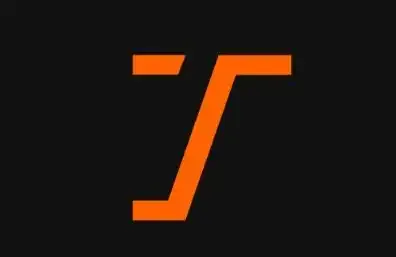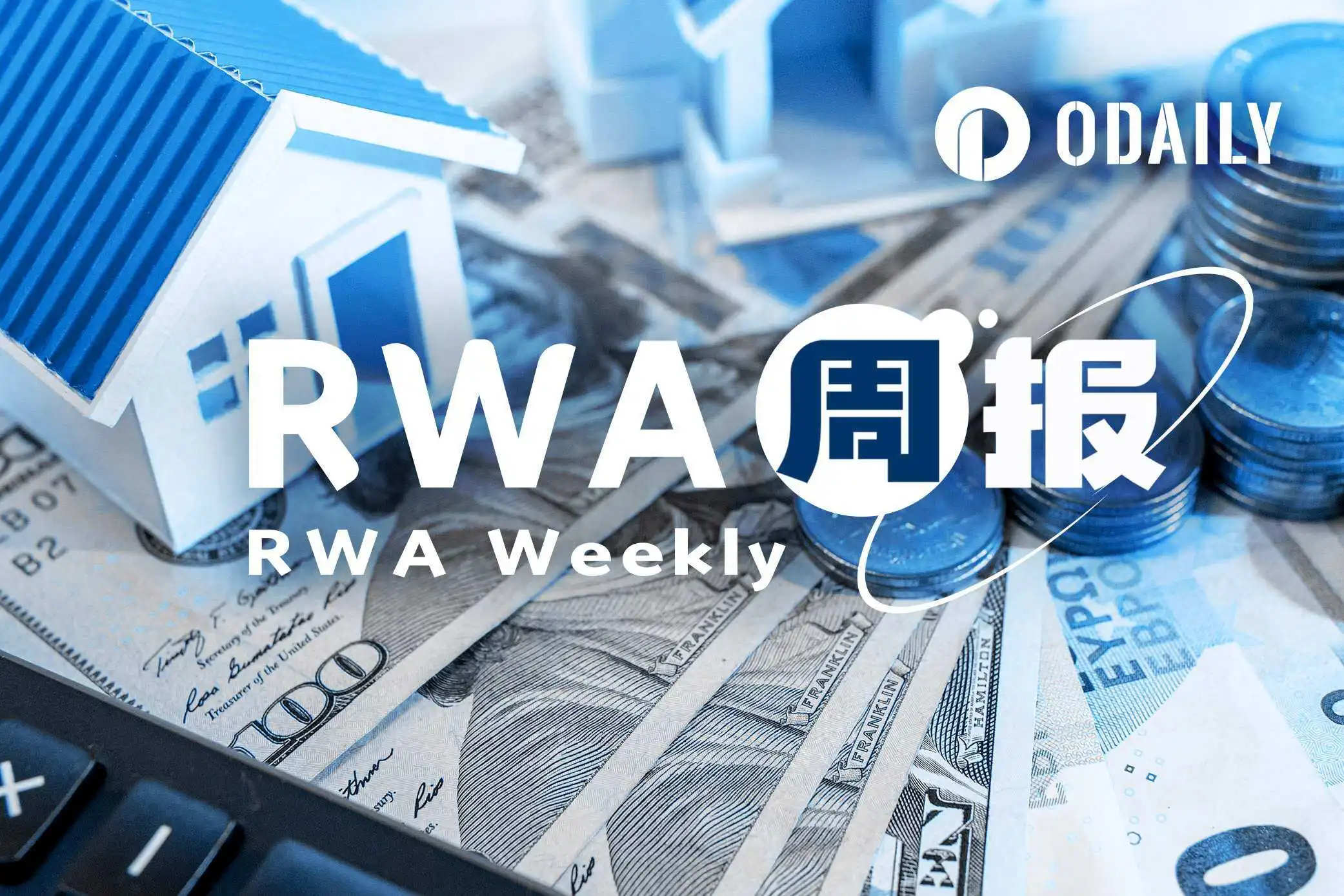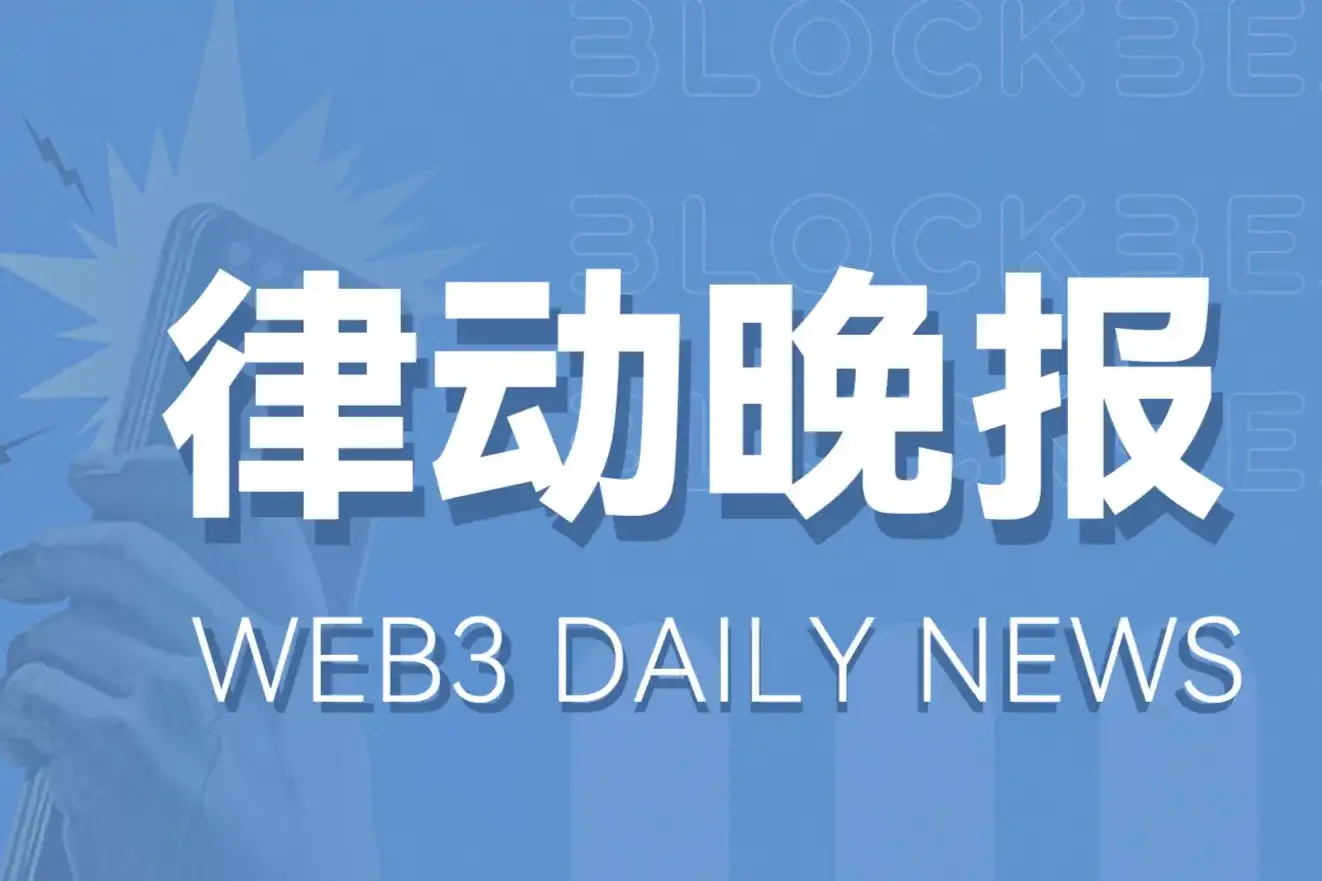Author: Biteye Core Contributor Viee
Editor: Biteye Core Contributor Denise
In the cryptocurrency industry, every bull market gives rise to countless "highlight projects": highly praised by top VCs, listed on mainstream exchanges, and attracting numerous retail investors. However, time is the sharpest touchstone; some projects have seen their prices drop by 90% or even over 99% compared to their peak, with discussions around these projects declining year by year.
This article reviews 8 projects that were heavily invested in by star VCs and were once highly anticipated during the bull market phase. From ICP to DYM, we will focus on analyzing their financing backgrounds, market cap changes, and the deeper reasons behind their plummeting values—whether it’s due to unsustainable models, delayed ecosystem launches, or strong competitors and insufficient market demand.
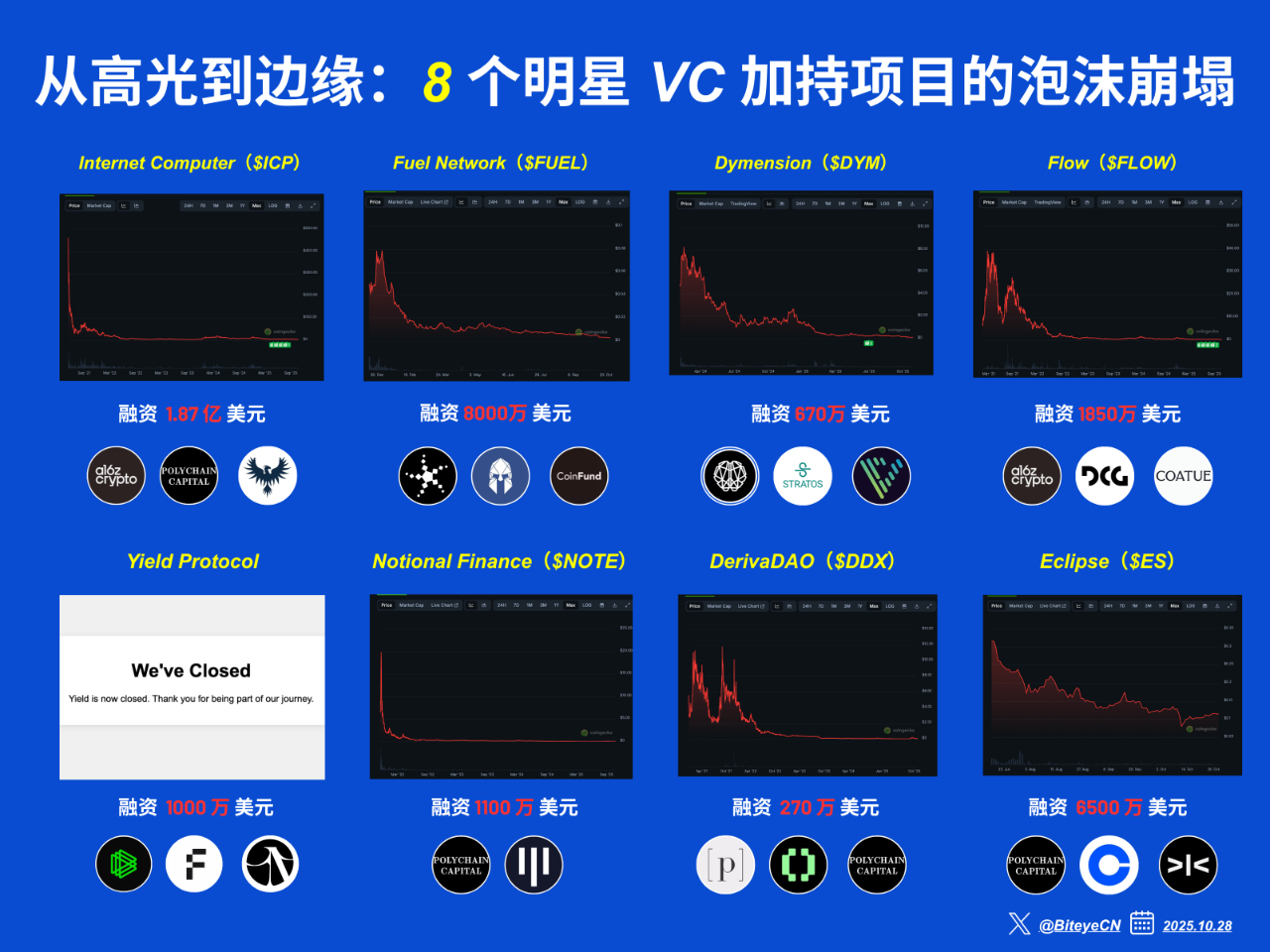
01 Internet Computer ($ICP)
Once in the top five, now down 99.5%
Internet Computer (ICP) was launched by the Dfinity Foundation, positioned as a decentralized "Internet Computer," aiming to allow smart contracts to natively run various internet services. The project began development in 2018 and was launched for trading in May 2021 at the peak of the bull market, entering the top five in cryptocurrency market cap on its first day, attracting significant market attention.
ICP was backed by top Silicon Valley venture capital firms, including a16z, Polychain Capital, Multicoin, and CoinFund, with total funding reaching $187 million. The initial price of ICP was as high as several hundred dollars, peaking near $700, but it quickly fell back after launch, dropping below $20 within two months. By 2025, ICP lingered around $3, down over 99% from its peak.
The main reasons for the project's failure include valuation bubbles, rushed launches, initial liquidity shortages, and external doubts about project governance and centralization. Additionally, slow ecosystem development has failed to fulfill early promises of "rebuilding the internet."
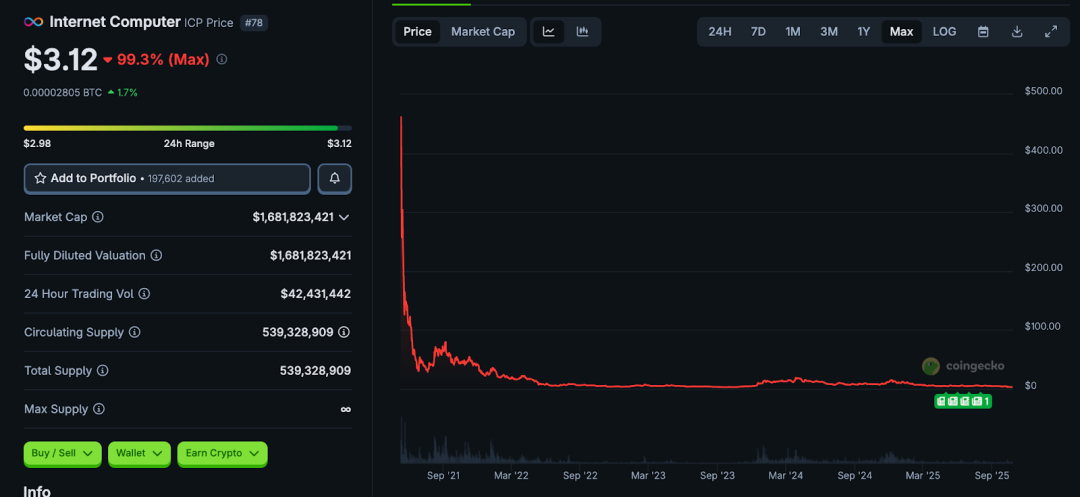
02 Fuel Network ($FUEL)
Ambitions for a modular execution layer, reality yet to be fulfilled
Fuel Network is a Layer 2 solution aimed at scaling Ethereum, with the core goal of separating the execution layer from consensus and data availability to improve throughput and reduce costs.
The project has received support from institutions including Blockchain Capital, The Spartan Group, and CoinFund, with strategic financing reportedly reaching at least $80 million.
However, in terms of token performance and ecosystem implementation, Fuel Network has not met expectations. FUEL is currently priced at about $0.003, with a market cap of only several million dollars, down over 94% from its peak. With Ethereum scaling, various L2, and modular chain solutions emerging, whether Fuel can maintain its differentiated advantage in the long term remains uncertain.
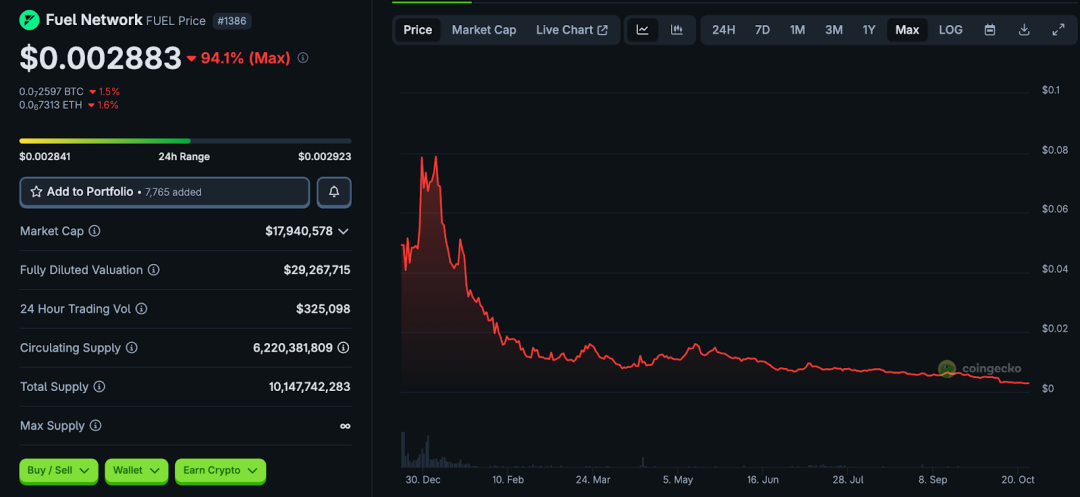
03 Dymension ($DYM)
A new attempt at RollApps architecture, price has dropped over 97%
Dymension is a project focused on "modular blockchain" infrastructure, primarily aimed at allowing developers to quickly deploy application-specific blocks ("RollApps") on an L1 network. Its design aims to separate consensus from settlement layers and optimize scalability and customization through the construction of RollApps within the ecosystem.
The project started in 2022 and launched its token DYM in early 2024. Despite having a clear technical positioning and support from multiple investment institutions including Big Brain Holdings, Stratos, and Cogitent Ventures, DYM's market performance shows that its current price has dropped over 97% from its peak. Data indicates its historical high was around $8.50, with the current price in the range of about $0.10. Although the project is still operational, ecosystem development is slow, and community and user engagement have not met expectations.
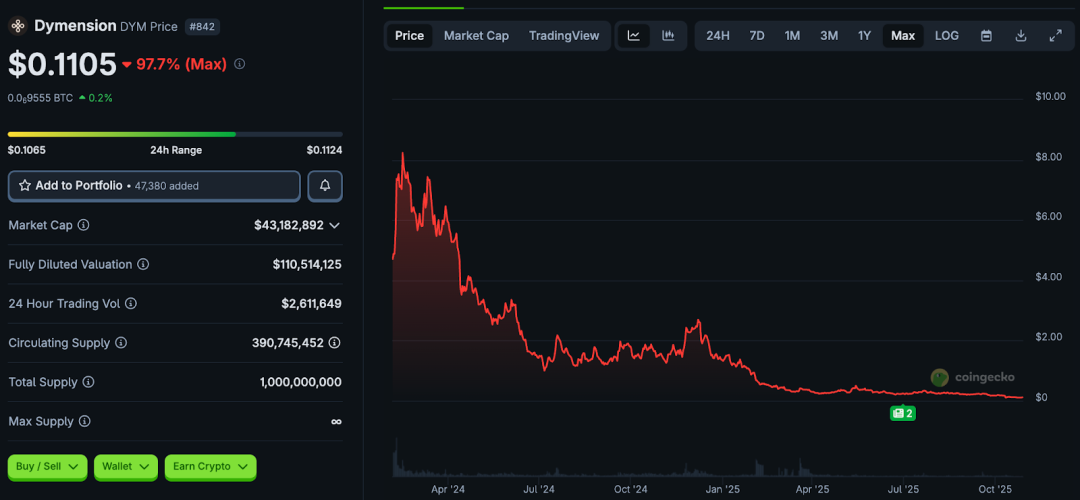
04 Flow ($FLOW)
Once a star NFT chain, now losing attention
Flow is a high-performance public chain launched by Dapper Labs, focusing on NFT and gaming applications. In October 2020, the FLOW token was publicly launched on CoinList, and with the NFT boom in 2021, the ecosystem was once very active.
The financing lineup behind it is strong. Dapper Labs received multiple rounds of investment from a16z, DCG, Coatue, and other institutions between 2018 and 2021, with total funding exceeding $185 million. FLOW reached a historical high of about $42 in April 2021, but has since continued to decline with the market. By 2025, the price had dropped to $0.28, down over 96% from its peak, and its market cap has also significantly shrunk.
Flow's decline is closely related to the cooling of the NFT market. The ecosystem relies on a single blockbuster application, lacking sustained growth momentum, and in the long run, it lacks user retention and real demand support.
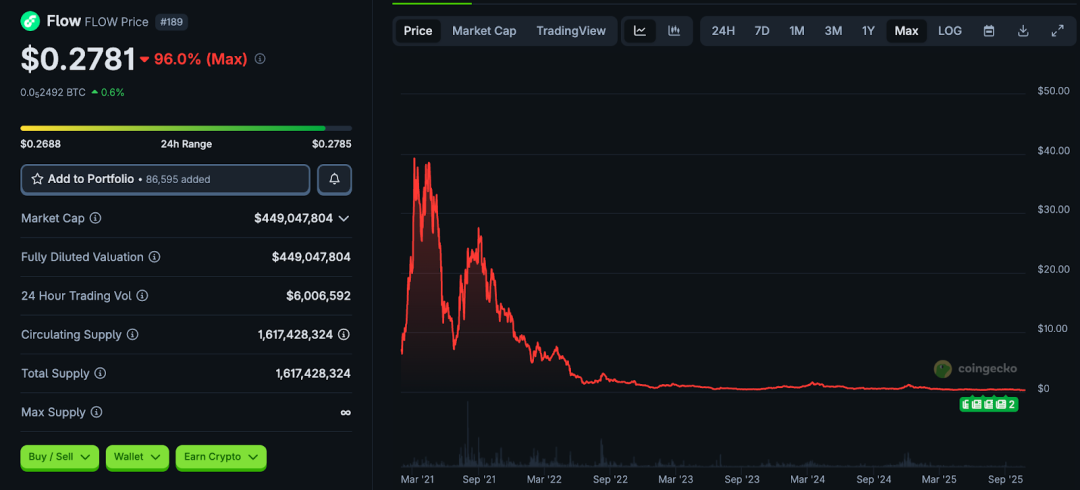
05 Yield Protocol
A fixed-rate protocol supported by Paradigm, closed in 2023
Yield Protocol is a lending protocol based on Ethereum, focusing on fixed-term, fixed-rate lending, and achieving bond-like lending products through the issuance of fyToken. The project launched in 2019 and was seen as one of the explorers in the DeFi fixed income space.
In June 2021, Yield completed a $10 million Series A funding round led by Paradigm, with participation from well-known institutions such as Framework Ventures and CMS Holdings.
However, in October 2023, Yield Protocol officially announced the closure of the protocol, and its website was subsequently taken offline.
The core reason for the project's failure lies in insufficient demand for fixed-rate lending, making it difficult to maintain an effective market. Additionally, in the context of an overall downturn in the DeFi market and increasing regulatory pressure, Yield was unable to form a sustainable product model and ultimately chose to cease operations, becoming one of the few star VC-supported projects to officially close in recent years.
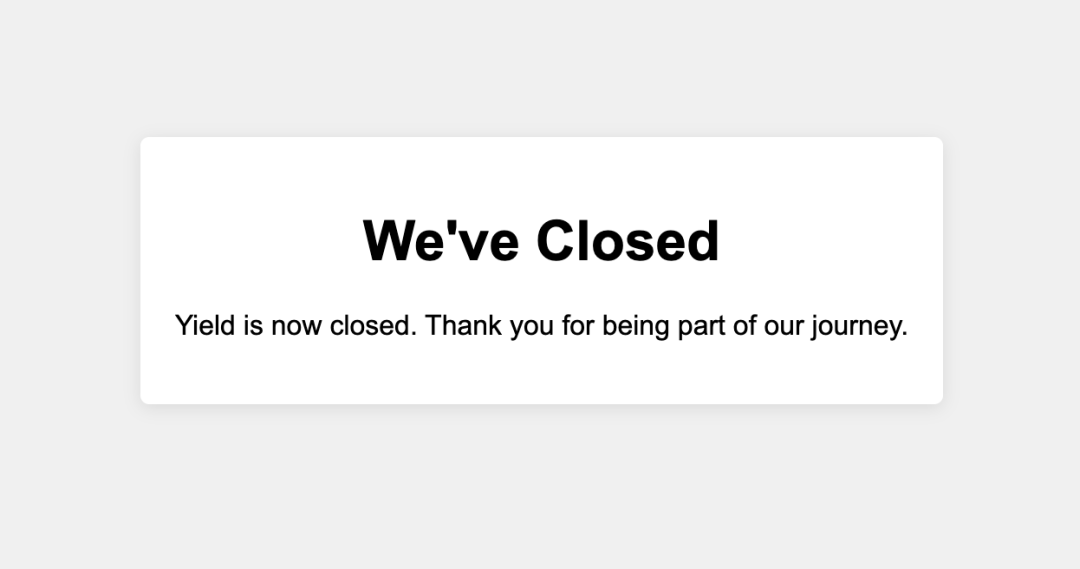
06 Notional Finance ($NOTE)
A fixed-rate lending protocol gradually marginalized
Notional Finance is a fixed-rate lending protocol deployed on Ethereum, allowing users to borrow USDC, DAI, ETH, WBTC, and other assets for fixed terms, attempting to fill the gap for "stable income" products in the DeFi market.
In May 2021, Notional completed a Series A funding round led by Coinbase Ventures, with participation from top institutions such as Polychain Capital and Pantera Capital, raising over $11 million in total.
By 2025, the market cap of the NOTE token was only about $1.66 million, down over 99% from its peak, with daily trading volume below a thousand dollars, and both community activity and protocol update frequency were low.
The core issues faced by Notional are similar to those of Yield Protocol: the user acceptance of fixed-rate products in the DeFi market has always been limited, lacking sufficient liquidity support. Additionally, its design differs significantly from mainstream lending protocols, leading to low user migration willingness, ultimately resulting in gradual marginalization by the market.
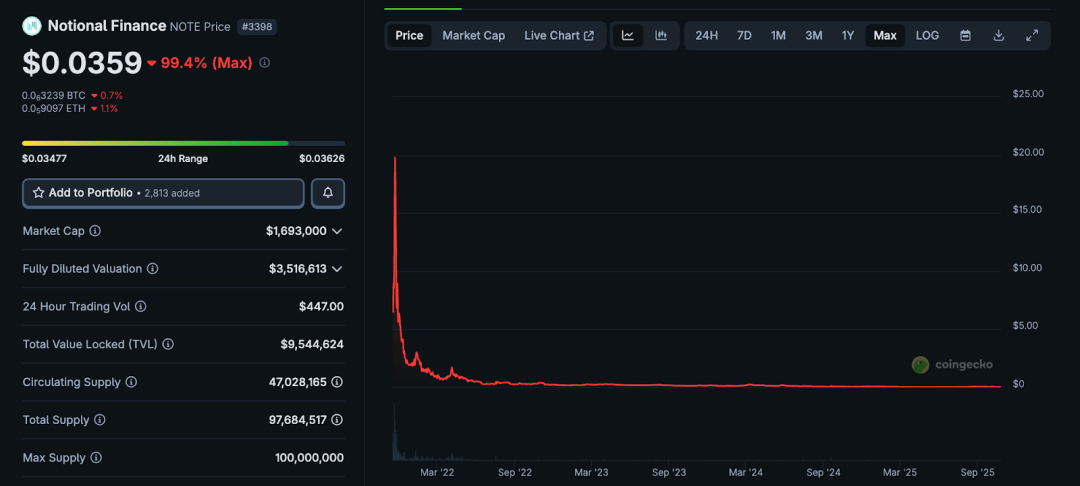
07 DerivaDAO ($DDX)
From a star derivatives DEX to marginalization
DerivaDAO is a decentralized perpetual contract exchange project, first proposed in 2020, positioned as a derivatives platform that combines the operational experience of CEX with the security of DEX. The project emphasizes community governance, attempting to replace centralized operations with a DAO model.
In July 2020, DerivaDAO received investments from top VCs including Polychain, Coinbase Ventures, and Dragonfly, raising a total of $2.7 million. Although the amount is not large, the lineup is considered star-level. After launching in 2021, the price once reached about $15 but quickly fell back. By 2025, DDX lingered in the range of $0.01 to $0.04, down over 99% from its peak, with the project's market cap nearly zero.
Due to the product's delayed launch and lack of competitive features, combined with an early aggressive mining incentive mechanism that led to rapid token release without actual trading demand to support it, DerivaDAO faced strong competition from players like DYDX, making it difficult to break through.
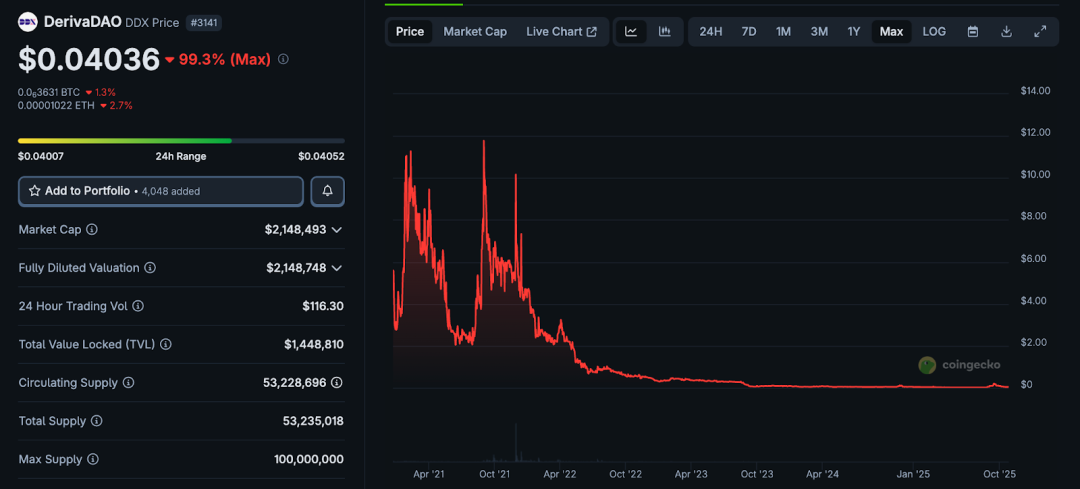
08 Eclipse ($ES)
A new generation of L2 infrastructure trial, down over 64%
Eclipse is a Layer 2 solution that combines the security of Ethereum with the high performance of Solana. The project plans to launch its mainnet in 2024 and start its token ES in July 2025.
The project has received investments from well-known VCs including Placeholder, Hack VC, and Polychain Capital, with a financing scale of about $65 million.
However, from the market performance perspective, the valuation of the ES token has seen a significant pullback. According to CoinGecko data, although ES is still trading, it has dropped about 64% from its peak. The Eclipse ecosystem is still in its early stages, with fierce competition among roll-up or modular chain solutions, and multiple projects vying for the L2 track, with the project's market landing path not yet fully revealed.
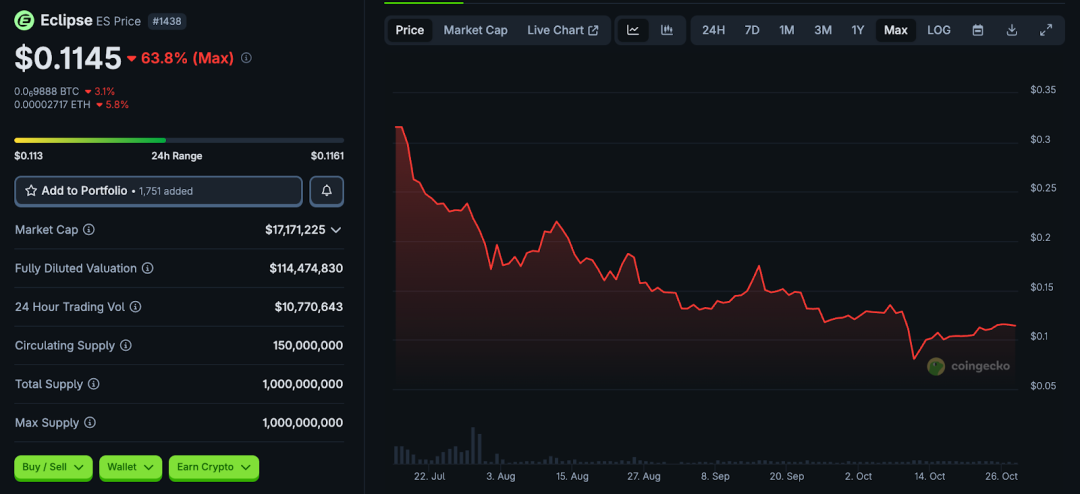
09 Conclusion
This article is not meant to criticize or create emotions, but rather to provide a calm review of the "crash samples" from the last wave of enthusiasm before the next cycle arrives.
They once had the most dazzling capital, narratives, and communities—but still failed to escape the trajectory of decoupling, collapse, loss of momentum, and marginalization. In a market where finance and technology are highly intertwined, relying solely on financing, token prices, and topic popularity is far from enough. Are the business models viable? Can users be retained? Is the product continuously advancing? These are the core variables that truly determine the fate of a project.
These stories also remind us not to just look at VC endorsements or short-term surges, but to learn to identify whether the long-term structure is sound.
When the tide goes out, what remains is the true value.
免责声明:本文章仅代表作者个人观点,不代表本平台的立场和观点。本文章仅供信息分享,不构成对任何人的任何投资建议。用户与作者之间的任何争议,与本平台无关。如网页中刊载的文章或图片涉及侵权,请提供相关的权利证明和身份证明发送邮件到support@aicoin.com,本平台相关工作人员将会进行核查。
